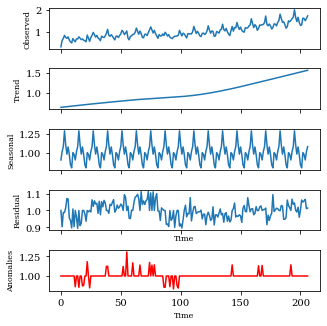AA-Forecast: Anomaly-Aware Forecast for Extreme Events
==============================If you find this code or idea useful, please consider citing our work:
title={AA-Forecast: Anomaly-Aware Forecast for Extreme Events},
author={Farhangi, Ashkan and Bian, Jiang and Huang, Arthur and Xiong, Haoyi and Wang, Jun and Guo, Zhishan},
journal={arXiv preprint arXiv:2208.09933},
year={2022}
}
Instructions on setting up your project locally or on a cloud platform. To get a local copy up and running follow these simple example steps.
This is an example of how to list things you need to use the software and how to install them.
- Tensorflow 2.1.1
- Nvidia GPU
Datasets are located in the data folder:
credit-card-sales-covid-19.csv electricity.csv tax-sales-hurricane.csv
-
Clone the repo.
git clone https://github.com/0415070/AA-RNN.git -
Install requirement packages.
pip install -r requirements.txt -
Run model.py after the dataset has been gathered. You can use make_data.py for this.
Contributions are what make the open source community such an amazing place to be learn, inspire, and create. Any contributions you make are greatly appreciated.
├── LICENSE
├── Makefile <- Makefile with commands like `make data` or `make train`
├── README.md <- The top-level README for developers using this project.
├── data
│ ├── external <- Data from third party sources.
│ ├── interim <- Intermediate data that has been transformed.
│ ├── processed <- The final, canonical data sets for modeling.
│ └── raw <- The original, immutable data dump.
│
├── docs <- A default Sphinx project; see sphinx-doc.org for details
│
├── models <- Trained and serialized models, model predictions, or model summaries
│
├── notebooks <- Jupyter notebooks. Naming convention is a number (for ordering),
│ the creator's initials, and a short `-` delimited description, e.g.
│ `1.0-jqp-initial-data-exploration`.
│
├── references <- Data dictionaries, manuals, and all other explanatory materials.
│
├── reports <- Generated analysis as HTML, PDF, LaTeX, etc.
│ └── figures <- Generated graphics and figures to be used in reporting
│
├── requirements.txt <- The requirements file for reproducing the analysis environment, e.g.
│ generated with `pip freeze > requirements.txt`
│
├── setup.py <- makes project pip installable (pip install -e .) so src can be imported
├── src <- Source code for use in this project.
│ ├── __init__.py <- Makes src a Python module
│ │
│ ├── data <- Scripts to download or generate data
│ │ └── make_dataset.py
│ │
│ ├── features <- Scripts to turn raw data into features for modeling
│ │ └── build_features.py
│ │
│ ├── models <- Scripts to train models and then use trained models to make
│ │ │ predictions
│ │ ├── predict_model.py
│ │ └── train_model.py
│ │
│ └── visualization <- Scripts to create exploratory and results oriented visualizations
│ └── visualize.py
│
└── tox.ini <- tox file with settings for running tox; see tox.readthedocs.io

